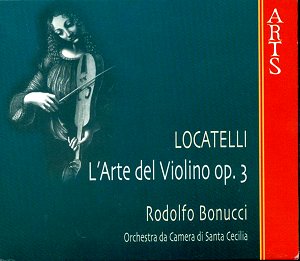These
famously pyrotechnic concertos, some of proto-Paganinian complexity,
show a more public virtuosity than the interior spirituality
of, say, Biber's Mystery Sonatas. Locatelli's own Sonatas -
he wrote a number - certainly lack the Bohemian composer's sense
of profound engagement but then Locatelli was writing from a
different compositional axis; a broadly Corellian-Vivaldian
one that took an admixture of Handel and larded it with moments
of extreme, if (in our terms) rather static melodrama. And his
Concertos are certainly chin-juttingly tough to play and have
provided fiddle players with quite sufficient difficulties over
the years. The fearsome few tend to dig out the solo sonatas
- Ricci, Staryk, Kremer amongst them - whilst such as the pioneering
Lautenbacher have given us complete sets of the concertos.
Adopting
elements of the church sonata he added finger busting double
stops and exceptionally difficult writing in the soprano register,
playing that tests agility, digital accuracy and intonation
to the maximum. All the concertos contain caprice-cadenzas,
moments when the soloist lets loose with a battery of florid
cadential dramas – not for nothing was Locatelli known colloquially
as The Earthquake. Slow movements are lyrically etched,
such as the first in D major. Opening movements, as often as
not Andantes, can move, as in the case of the C minor [No.2]
with noblest of treads whereas Vivace finales can tend toward
the vocalised and possess real lyric generosity, though there
are dangers aplenty. In the finale of the F major Bonucci’s
intonation is compromised somewhat and there are instances of
strained passagework, though as elsewhere he remains elegant
and generally unruffled by the exorbitant demands placed on
him.
Such
things may seem schematic but Locatelli cannily varies texture
and tone; the stratospheric finger board work in the concertante
parts of the E major [No.4] are contrasted with the greater
concentration on the lower strings in the powerhouse cadenza.
And lest one think him a flâneur, melodically speaking, he spins
a haunting Largo in the same Concerto. He also manages
to spice up a compositional trick whereby the spaced orchestral
chordal introductions to the slow movement become, over time
and as the concertos develop, quicker. The move generally is
toward a greater concision of utterance and a greater compression
of musical ideas, even if in the case of the Largo of No.11
it has become generic through overuse, and even though the last
of the twelve, the G major Facilis aditus, difficilis exitus
(an appropriate Latin tag), has an inordinately long
but clever finale – the longest single movement of any of the
concertos.
So
Locatelli’s demands are well met in this recording. As I said
intonation is not always spot-on but the cadential passages
are taken with drive and not a little swagger, as they’re surely
meant to be. The band can sound a mite thin from time to time
and there were moments – I may be wrong – when the acoustic
for the cadenzas seems to change (were these taken down separately
or are they different takes?). But otherwise these performances
do well by the quirks and formidable demands – the little scotch
snaps, the Handelian cadences, the whistling harmonics, the
fearsome double stopping, the vertiginous in alt playing. All
are available singly but Arts has now brought them out in a
slipcase. If you prefer to sample you should start with volumes
two and four – plenty of variety.
Jonathan
Woolf

![]() Rudolfo Bonucci (violin)
Rudolfo Bonucci (violin)![]() ARTS
4772-2 [4 CDs in slipcase, individual details
as above]
ARTS
4772-2 [4 CDs in slipcase, individual details
as above]





